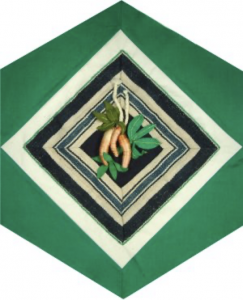Liberia

The Block
A three-dimensional cassava plant surrounded by appliquéd foliage is the central image of this block fashioned by mother and daughter team, Mary Mamolu and Loupu Orogie. A perennial woody shrub with an edible root, cassava, also called yucca, manioc or madioca, grows in tropical and subtropical areas of the world and is one of Liberia’s staple foods. “Cassava is to the African peasant farmers what rice is to the Asian farmers, or what wheat and potato are to the European farmers.” Used mainly for human consumption, they are typically eaten freshly boiled or raw, and provide a basic daily source of dietary energy. In addition the roots are made into granules, pastes and flours, and the leaves are eaten as a green vegetable, providing protein and Vitamins A and B. The plant rests on a backdrop of ‘country cloth’, the national fabric that exemplifies the country’s strong tradition of skilled strip-weaving. The process involves making the thread, dyeing them with natural indigo dye or kola derived from various plants and finally doing the weaving on handmade loom. Each step is done with indigenous tools. The strips, which are typically four to five inches wide, are then sewn together to make traditional gowns for men and lappas for women. Such fabric is often used to create clothes for weddings and other important ceremonies.
Cultural Profile
Liberia, Africa’s oldest republic, borders the North Atlantic Ocean on the continent’s western side. Its name––derived from the Latin word for ‘free,’––was chosen in 1824 because the nation was created on land purchased by the American Colonization Society as a home for emancipated American slaves. Liberia, one of two African nations that have never been ruled by a foreign power (the other one being Ethiopia), is sometimes called the “Land of the Pepper Bird.” It is known for its extensive rubber plantations, while its Nimba Mountains are rich in iron ore. Diamonds and gold also account for a large part of Liberia’s economy. The nation’s indigenous population is comprised of 16 major ethnic groups, the largest of which is the Kpelle. The remaining inhabitants include Americo-Liberians (descendants of Americans freed people) and Congos (descendants of Caribbean freed people). The official language is English, although it is spoken and understood only by a minority of people, while nearly 20 native tongues, with 33 dialects, are widely spoken. Indigenous tribes in Liberia have held strongly to their beliefs and practices and as a result, social mores and traditions vary greatly throughout the country. There are however, common threads, including the customary greeting, “What is your tribe?” which is accompanied by a special handshake. The handshake or “snapshake” originated with freed slaves who considered the greeting a sign of their liberation. Liberian life revolves mainly around the village and tribal community, and traditional arts are an important part of the culture. The traditional music of the country features call-and-response songs as well as talking drums, balafons and musical bows. Choir music and highlife, an Akan and jazz hybrid, are also very popular in Liberia. Ethnic groups have rich traditions of dance and story-telling, two art forms in which legends, customs and life lessons are passed down through the generations. Secret societies are prevalent and within the women’s society, Sande, female-only competition dances and tribal masking rituals––which are limited to men in other African societies––take place. Liberians are renowned wood-carvers. Their masks are a central part of cultural practices such as mask dances, with some of them considered so sacred that they can only be seen by a selected, initiated few. Bronze and brassware are also important handcrafts. Notable textile arts, besides weaving, include quilting and embroidery, a legacy from freed American slaves who brought their sewing kits and traditions with them when they emigrated to Liberia during the 19th century. It is still customary for Liberian presidents to offer a quilt to visiting dignitaries. In addition to the woven country cloth, tie-dye cloth, batik and wax prints are also popular textiles made in the country. People have been coming to Canada for decades, however the 2011 census reports less than 1,700 Liberians currently here. Many Liberians who emigrated as a result of civil unrest during the 1980s and 1990s went to the United States, somehow making history come full circle. There they have established numerous associations and are very active in preserving their cultural roots.
Sponsor: Booth family, in memoriam Michael David Booth
